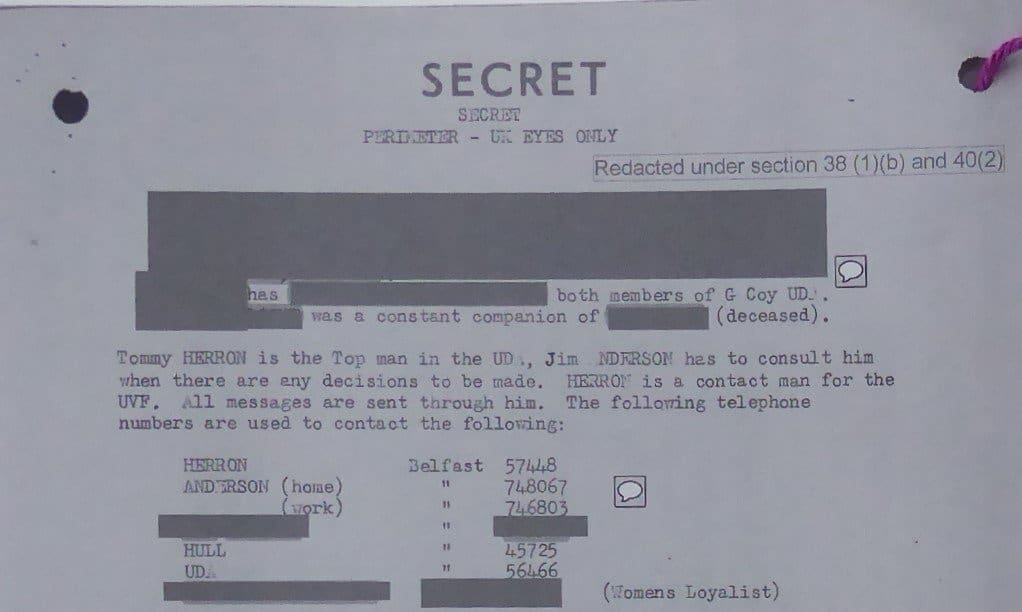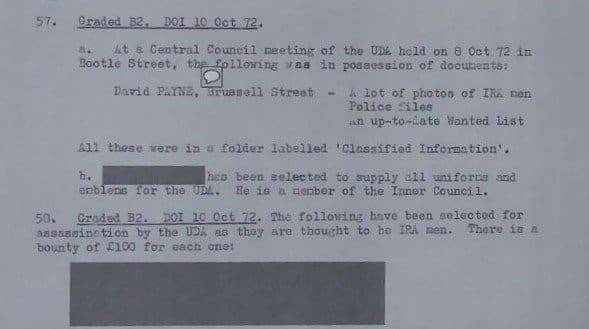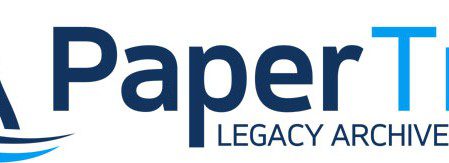Secret British Army documents prove just how close its agents were to Ulster Defence Association (UDA) leaders and UDA “Romper Room” killers in the winter of 1972.
The previously unseen British Military Intelligence files lead families to question why the killers were not stopped long before many other Catholic civilians died at their hands.
Paper Trail has been working with a number of families whose loved ones were murdered by the UDA’s notorious G4 Romper Room killers led by Ned McCreery and British soldier Albert “Ginger” Baker in 1972.
G4 referred to Number 4 Platoon of G Company UDA in the Lower Newtownards Road area of East Belfast. In these British military files, the gang is also referred to as the Young Newtons.
Romper Rooms
They have a particularly dark space reserved in our shared history due to the terrible deaths they gave their victims in “Romper Rooms”.
The torture chambers became known as “Romper Rooms” in UDA parlance after the children’s television show and “rompering” referred to the vicious beating and torturing of victims prior to their murder.
The gang was responsible for multiple murders from the summer of 1972 to the late winter of 1973.
Baker was alleged to have deserted the British Army during the period, but families believe this was just a cover and he was still very much a British soldier just as Brian Nelson was in west Belfast at the same time. Another “former” British Army Special Force soldier was a commander in the Londonderry Brigade of UDA throughout this period too.
Paper Trail discovered and targeted closed British Military Intelligence documents via the Freedom of Information Act. The charity secured redacted copies from the British Ministry of Defence and National Archives following protracted information battles including Public Interest Tests.
Some information regarding the Young Newtons was redacted wholesale even though we had requested it specifically. In the same files, the British Ministry of Defence passed information relating to the murder of a UDA leader and a UDR soldier “ringleader” in charge of a UVF unit linked to an arms find and over a dozen attacks in the Carrickfergus area.
Nevertheless, even the redacted files prove shocking and support what the families of victims have long feared. They also prove that British Military Intelligence had a particular interest in the Romper Room Gang and received a continual flow of high-grade information from at least one trusted source throughout this period.
Gangs and Counter-Gangs
The secret files include British military intelligence reports from agents and their grade. British agents are graded from A – F depending on the reliability of the source, with A being the most reliable and B usually reliable down to F, a source of unknown reliability.
The information they give is then rated 1 – 6, with 1 being most reliable and confirmed by independent sources, down to 5 being improbable and 6 unknown or undetermined.
We know from previous files discovered by Paper Trail that the British Army had been collating massive amounts of intelligence on Loyalist paramilitaries and the structure of their organisations throughout the whole of 1972 although only Irish Catholics were being interned at the time.
These particular discoveries prove that not only were trusted British agents reporting on strategic discussions at the leadership level of Tommy Herron and Jim Anderson, but also at unit level.
British Military Intelligence focused on the UDA’s Romper Room Gang especially in these files.
A source or sources Graded A2 by British Military Intelligence provided information relating to numerous killings including a number of unsolved murders.
One British Military Intelligence file recovered by Paper Trail and signed off in December 1972, includes two incidents involving “The Young Newtons – G4 Coy [Company] UDA, East Belfast”.
DOI is Date of Information rather than Date of Incident, so this intelligence from an A2 source came in on the night of the incidents.
The first redacted information relates to the murder of Joseph McIlroy on 21st November 1972 but the second is redacted wholesale except for the comment below. Patrick Benstead became a torture victim and young mother Sandra Meli was shot dead by the G4 gang that night, but these horrific murders may be incidental if the information does not relate to either murder.
Nevertheless, Paper Trail has also discovered high-grade British Military Intelligence relating to both murders in other files and passed it to family campaigners and their legal team.
The Murder of Joseph McIlroy
The redacted information appears to cover the names of the alleged killers of Joseph McIlroy and the authorities received the intelligence from their A-Grade source that night:
“The Young Newtons – G4 Coy [Company] UDA, East Belfast
(1) Graded A2. DOI [Date of Information] 21 Nov 72. It has been alleged that Joseph McIlroy, Sandhill Dve [Drive], was shot by [REDACTED]
(2) Graded A2. DOI 2 Dec 72. [REDACTED WHOLESALE]
COMMENT: [REDACTED]. Both members of UDA with connections with the Young Newtons. 6 shots were fired at Willowfield RUC Stn [Station] that night, but there were no casualties and SF [Security Force] follow-up revealed nothing.”

The second article of A2-graded intelligence may refer to the murder of Patrick Benstead and/or Sandra Meli by the same group that night too.
Please note also, these are Intelligence Summaries so more extensive reports exist elsewhere in British Ministry of Defence stores unless MoD has already deliberately destroyed them.
The Royal Ulster Constabulary (RUC) told his inquest that Joseph McIlroy (32) - a married Catholic civilian with four young daughters - was murdered by Loyalists simply because he was a Catholic. The family were only one of a few Catholics remaining in the Orangefield area at the time.
Joseph was the brother of the grandfather of the world-renowned golfer, Rory McIlroy, making him the famous sportsman’s great-uncle.
His murder was considered in later news reports and Lost Lives as a UVF killing. This high-grade intelligence records it as a G4 UDA murder which therefore connects it to a gang of serial killers operating in the area at the time who killed more than 20 victims between June 1972 and February 1973 in East Belfast.
Joseph McIlroy’s murder would add another murder victim to this terrible list.
Serial Killers
One of those serial killers was Albert “Ginger” Baker who confessed to 4 murders and 11 robberies. When he confessed to these in 1973, he testified he was a British Army deserter from the Royal Irish Rangers in June 1972 before joining the UDA.

As well as being involved in the G4 unit’s most brutal murders, author Martin Dillon wrote that Baker was highly regarded by Tommy Herron who was the UDA’s East Belfast commander. Herron used Baker as a bodyguard and personally ordered Baker to murder Anthony Faye on 18th August 1972 simply because Faye was a Catholic who was working at a hotel where the UDA met.
Baker’s original statement states coldly:
“The first one was a bloke in Island Street… I went down and knocked this door and he came down and I asked him if he was a Roman Catholic and he said ‘Aye’ and I shot him five times in the head. He had black curly hair. I shot him twice in the back of the head and three times at the side just by the ear.”

After Baker’s imprisonment, he alleged that he was a high-placed agent working for the British Army as a member of its Military Reaction Force but his credibility was shot to pieces by then. It has since been recorded that he was a member of the elite 22 SAS and had trained in Fort Bragg with American Special Forces.
Nevertheless, we see in these secret files that there was indeed at least one trusted British Military Intelligence source who was not only reporting on the brutal murders of Catholic civilians in romper rooms but also on high-level meetings of the UDA’s Inner/Security Council.
If it was not Baker, who was it?
Continued below... //

Subscribe to the Paper Trail Blog
Read critcal archive finds and new reports first.
Thank you.
As discussed above, we know that British Military Intelligence had begun building comprehensive files on all Loyalist personalities at every level when Direct Rule was established in March 1972.
Read Britain's Failure to Proscribe Loyalist Extremist Groups >>>
British Intelligence files for May 1972 record how they have been able to compile such an extensive list of UDA members for each Company across Belfast:
“The leaders are comparatively open about their organisation and consequently a large number of names have been forthcoming.”
British military infiltration was obviously easy.
The Murder of James McCartan
When Catholic civilian, James Patrick McCartan was kidnapped from an East Belfast hotel by the UDA on 3rd October 1972, an Intelligence Captain serving with the resident British Army Battalion went to the Sydenham UDA Club in Inverwood Gardens (G6 UDA) and asked to speak directly to two UDA leaders he knew and who would later stand trial for the murder of Patrick McCartan.
Different units and even members of different organisations could be involved in local incidents.
The two UDA men arrived and the Captain asked them if he knew where McCartan was. They said they did not. McCartan’s battered body was found later, a 2-minutes’ drive away.
Baker’s original statement records [Image 5]:
“I think we broke the bones in his back with a pick shaft. We stabbed him in the hands and just above the right thigh. We took him to Connswater Bridge in Mersey Street and I shot him three times in the head after I put a green hood over his head… He was the second.”

Paper Trail discovered and recovered the British military files for this period as it supports a number of families whose loved ones were bereaved in 1972.
We picked up a British Military Intelligence source who reported on 5th October and was graded B2 – which was considered reliable and consistent (but still unconfirmed by other sources). This source reports on G Company UDA specifically:
“Graded B2. DOI 5 Oct 72.
(1) G Coy of the UDA is responsible for the Newtownards Road part of Ravenhill and Woodstock Road. The OC [Officer Commanding] is [NAME REDACTED] of [ADDRESS REDACTED]. 2IC [Second-in-Command] is “Major” [NAME REDACTED] the coy [ company] is divided into sections G-A1, G-A2, G-A3 etc and also operates in Ballybeen and Tullycarnett. Other officers in the coy are “Major” [NAME REDACTED] of Braniel and [NAME RADCATED] of [ADRESS REDACTED].
(2) It is rumoured that the Inner Council intend to oust [NAME REDACTED] in the near future as he will not accept order or enforce discipline among his men. The coy has been responsible for some small shop robberies and the Inner Council has ordered that these must cease.
(3) [NAME REDACTED] of [ADDRESS REDACTED] Belfast, is Bn [Battalion] Commander for the East Belfast UDA.”

These may be the same robberies carried out on the local East Belfast community by Baker at the time; and the named Commander may be Tommy Herron although, if so, his name need not be redacted here as he was killed by the UDA in 1973.
Later files record redacted names of G4 and information on the UDA's leaders:
“Tommy HERRON is the Top man in the UDA. Jim Anderson has to consult him when there are any decisions to be made. HERRON is a contact man for the UVF. All messages are sent through him. The following telephone numbers are used to contact the following:
HERRON Belfast 57448
ANDERSON (home) “ 748067
(work) “ 746803
UDA “ 56466

Davy Payne and RUC Collusion
The flow of intelligence was not one way either as the British Military Intelligence files record classified RUC information in the hands of UDA leader Davy Payne at a high-level UDA meeting. Payne (1) had been running his own Romper Room torture chambers in West Belfast from July 1972.
“Graded B2. DOI 10 Oct 72
- At a Central Council meeting of the UDA held on 8 Oct 72 in Bootle Street, the following was in possession of documents:
David Payne, Brussell Street - A lot of photos of IRA men
Police files
An up-to-date Wanted List
All these were in a folder labelled ‘Classified Information’…
Graded B2. DOI 10 Oct 72. The following have been selected for assassination by the UDA as they are thought to be IRA. There is a bounty of £100 for each one:
[NAMES REDACTED]”

Working closely with Payne at this time was one Brian Nelson, another British soldier (Black Watch) who was alleged to be AWOL but Paper Trail and family research indicates he was acting in a similar capacity to Albert Baker in 1972.
Nelson stood trial in 1973 after being collared by a passing British Army patrol when he was leaving a romper room in West Belfast with his victim, a blind Catholic civilian called Gerald Higgins. Higgins was tortured to near death and was being led away to be shot when the British Army patrol happened upon them.
Listen to Paper Trail Pro Podcast on Brian Nelson
Whilst Nelson was only sentenced to 3 years in an outrageous trial. The files secured by the victim’s campaigning daughter and Paper Trail prove that Nelson was not AWOL at the time and was interviewed by British Military Intelligence before being handed over to the RUC.
Furthermore, the British state has not been able to prove to the family that Nelson actually served any time in prison.
Nelson stood trial 20 years later, but the British state only admitted that he was their agent from the mid-80s. Nelson had helped refine the UDA’s targeting using Security Force information. He had also helped to re-arm the UDA under the aegis of British Military Intelligence.
Whether this collusion between the RUC and Payne’s unit in October 1972 resulted in anyone being targeted and killed is unknown as the alleged IRA named are blanked out. We also do not know whether the British Armed Forces warned the victims that their lives were at risk.
Davy Payne has been named in conjunction with a number of West Belfast Romper Room murders including that of Francis Arthurs.
Serial Killers
In East Belfast a few days later, Catholic Terence Maguire was battered and shot to death on 14th October. His body was dumped in an alley off Clandeboye Street.
The same group is also suspected of murdering Catholic worker, Joseph Kelly, on a bus after he finished work on 8th December 1972.
Joseph Kelly’s son, also called Joseph, said:
“The East Belfast UDA was legal. It was armed, trained and sponsored by the British state. They were given a legal rubber stamped to commit mass murder in the name of the Secretary of State, MOD, and RUC. These are all culpable for deliberate missed opportunities to intern or even arrest these killers. If they had, they would have prevented the murders of scores of innocent people like my Dad.”
Catholic George Doherty was murdered in his own home off Upper Newtownards Road on 15th November one week later and less than a week before Joseph McIlroy was slain in his.
Patrick Benstead was picked up by the gang on 1st December 1972, tortured, and murdered in the early hours of 2nd December. His body was dumped in the same alley that the Romper Room Gang dumped Terence Maguire. The Irish News (4th December 1972) reported that the RUC described the death as a:
“… grisly, revolting murder by sadistic fiends who tortured him, burned his body and beat him unmercifully before shooting him through the head.”
Patrick Benstead’s naked body had extensive burns to the limbs, and the letters “IRA” [Irish Republican Army], the number “4” and a large cross burned into his back.
We know from the secret British Army document above that A2 intelligence was received regarding G4 on the date of his murder, but it is redacted and we will have to fight to secure access to it to prove it relates to either Patrick Benstead’s murder or the murder of Sandra Meli by the same gang.

What we have discovered is that B2 intelligence which we assume is from another reliable source (graded B rather than A) reported on 4th December 1972:
“[NAME REDACTED] is the official receiver for H and G Coys for all monies collected for the Loyalist Prisoners Association. (COMMENT: He is connected with the Young Newtons). The following members were armed with revolvers and pistols at UDA HQ on 2/3 Dec 72:
[POTENTIALLY 4 ROWS OF NAMES AND ADDRESSES REDACTED]
They drove about the Newtownards Rd area looking for Police patrols to shoot at. They reported back at UDA HQ at different times claiming hits on police vehicles.”

The authorities record above only shots fired at Willowfield Police Station and this is supported in British Military logs on the morning of 3rd December although the previous logs were retained:
“0320: RUC report of 6 shots at WILLOWFIELD from area of WILLOWFIELD GARDENS area at Police Station WILLOWFIELD”
Intelligence from a source graded A2 also reported on the G4 unit on 4th December:
“Information has been received that two of the persons responsible for the murder of Patrick Liam Benstead are [NAMES REDACTED].
The following day, a source graded B2 reported:
“At UDA HQ on night 2/3 Dec members discussed the murder of Patrick Benstead [REDACTED]. The following members who were all under the influence of drink boasted how the tortured BENSTEAD before shooting him:
[NAMES REDACTED]
[FURTHER REDACTIONS] The Young Newtons (who have boasted the kill of 4 RCs [Roman Catholics]) and units from Dee St and Sydenham, have been responsible for the spate of murders in East Belfast. The Sydenham unit is jealous of the success in these killings by the Young Newtons. The Sydenham units and Dee Street units work closely together. The Young Newtons HQ is Chadolly St, Belfast.
A British military INTSUM of 12th Dec records under Protestant Activities:
“4. Intimidation of Catholics living in Protestant areas has continued in the form of inter alia stonings and threatening letters. The recent murder of Patrick Benstead on 2 Dec is now believed to be attributable to the ‘Young Newtons’, the G4 Pl [platoon] of the UDA in East Belfast. There is also good reason to believe that the beating up of a Catholic youth on 8 Dec was carried out by the UDA.
- Searches of derelict houses used by the ‘Young Newtons” have resulted in a number of interesting finds including:-
- 200lb of illegal fertiliser chemical used for making explosives and four blast bombs.
- A .45 pistol, magazine and 6 rds [rounds] of ammunition
- A blood spattered room and a length of chain with traces of human hair (unconfirmed).
Comment: There is little doubt that this UDA unit North of the Newtownards Rd is responsible for a large number of the UDA crimes of violence in East Belfast. Personalities that have come to notice are:
[NAMES REDACTED]”

Patrick’s brother, Colum, has compiled an encyclopaedic history of the Romper Room Gang in his pursuit of truth and justice over the last half century. He said this about the files:
“My brother’s murder and all the other murders carried out by Unionist paramilitaries go beyond collusion. Those who organised and carried these murders were directed, armed and protected by the British State. Failure to protect those same agents would expose the state’s role in establishing and directing them to begin with. They were official and unofficial agents of that state, in or out of uniform.”
Kevin Winters of KRW Law represents many of the families bereaved by the Romper Room Killers. He said of these files:
"The latest revelations from Paper Trail are an important addition to the evidence we have to connect State liability to our pending high court actions in Benstead, McCartan, and many other linked cases."
Britain's Failure To Proscribe the UDA
At the time that Irish Catholics were being interned without trial, the UDA in East Belfast murdered over 20 civilians, attempted to murder many more, and was responsible for a conflagration of intimidation, theft and lawlessness in the area.
Amid this chaos and mayhem, the Romper Room Killers have become a by-line in our sordid history for their savagery and inhumanity. These files prove that the gang was not only of particular interest to the British military, but heavily infiltrated by it.
This has been denied by the British authorities up until the present day.
Whilst it could be argued that the authorities then began to act against the gang to take it off the streets, the families argue that many lives could have been saved long before, and that the British authorities ultimately failed as the most brutal members of G4, including Ned McCreery and his cousin, continued to kill into the 1990s.
The failure to proscribe the UDA will also feature in future litigation as it may surprise some readers from outside Ireland that the UDA was a legal organisation under British law until 1992. By then it had murdered over 400 people, the vast majority of them Catholic civilians and many its own members.
The UDA serial killers in East Belfast from summer of 1972 to late winter of early 1973 therefore account for over 5% of the UDA’s total murders over the 21 years that the British state failed to proscribe it.
In writing this I considered whether Britain would have allowed the UDA to flourish in Birmingham or Bristol rather than Belfast. Or would the British state allow a gang of serial killers murder civilians in Manchester once it had infiltrated it and had agents reporting back directly.
They allowed it to happen here.
British Soldiers, British Agents, and the UDA's Romper Rooms Part II
In our next instalment, Paper Trail will discuss how Belfast UDA meetings with Londonderry UDA provided the template for a rise in violence in the north of the country as well as a spate of murderous cross-border killings in late 1972/early 1973. Knives were used in a number of these slayings.
It also connects alleged Special Force operative, Albert Baker, to another British Army Special Force veteran who was in command of the Londonderry Brigade of the UDA, Andy Robinson. Again, secret British Military Intelligence files prove that there was at least one high-level agent reporting directly to the authorities at a time when the Londonderry Brigade was committing mass murders and killing Irish citizens in the Republic of Ireland.
The files also explain how grenades from Londonderry Brigade found their way to the hands of Albert Baker and were used in the murder of Catholic worker Patrick Heenan on 1st February 1973.
NOTES/AMEND
(1) Davy Payne is referred to as a former member of the Parachute Regiment in secondary sources but this has been queried by trusted sources. Paper Trail has worked with other researchers to discover the genesis of this assertion as we have yet to find proof from British military records that he served in the British Army. We have opened this as a separate point of research as Payne's alleged service was judged important considering his standing in the UDA, his relationship as a UDA leader with the British military in similar files, and the methods used to torture and kill.
As it stands, we have information from an extended family member and researchers, including Loyalist researchers, that Payne was never a member of the British Army.



